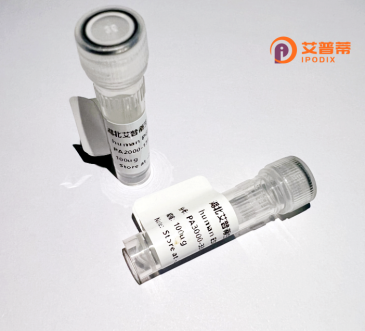
| 纯度 | >90%SDS-PAGE. |
| 种属 | Human |
| 靶点 | DEF6 |
| Uniprot No | Q9H4E7 |
| 内毒素 | < 0.01EU/μg |
| 表达宿主 | E.coli |
| 表达区间 | 1-100aa |
| 氨基酸序列 | MRTLTILTAVLLVALQAKAEPLQAEDDPLQAKAYEADAQEQRGANDQDFAVSFAEDASSSLRALGSTRAFTCHCRRSCYSTEYSYGTCTVMGINHRFCCL |
| 分子量 | 37.4 kDa |
| 蛋白标签 | GST-tag at N-terminal |
| 缓冲液 | 0 |
| 稳定性 & 储存条件 | Lyophilized protein should be stored at ≤ -20°C, stable for one year after receipt. Reconstituted protein solution can be stored at 2-8°C for 2-7 days. Aliquots of reconstituted samples are stable at ≤ -20°C for 3 months. |
| 复溶 | Always centrifuge tubes before opening.Do not mix by vortex or pipetting. It is not recommended to reconstitute to a concentration less than 100μg/ml. Dissolve the lyophilized protein in distilled water. Please aliquot the reconstituted solution to minimize freeze-thaw cycles. |
以下是关于重组人DEF6蛋白的3篇参考文献及其简要概括:
---
1. **文献名称**:*"DEF6 regulates immune synapse formation and dynamics in T cells"*
**作者**:Mavrakis K. et al.
**摘要**:该研究报道了重组人DEF6蛋白在T细胞免疫突触形成中的关键作用。研究发现DEF6通过激活Rho GTP酶家族成员(如Cdc42)调控细胞骨架重组,促进T细胞与抗原呈递细胞间的稳定接触,从而增强T细胞受体信号传导。实验中使用重组DEF6蛋白验证了其与GTP酶的相互作用机制。
---
2. **文献名称**:*"The guanine nucleotide exchange factor DEF6 governs autoimmune inflammation through transcriptional control"*
**作者**:Tanaka Y. et al.
**摘要**:研究利用重组人DEF6蛋白探明其在自身免疫性疾病中的功能。DEF6通过调控转录因子IRF4的活性,影响Th17细胞分化及炎症因子分泌。重组DEF6的体外实验表明,其缺失导致促炎因子IL-17表达下降,提示DEF6是治疗自身免疫疾病的潜在靶点。
---
3. **文献名称**:*"Recombinant expression and functional characterization of DEF6 in dendritic cell maturation"*
**作者**:Zhang L. et al.
**摘要**:该研究成功在大肠杆菌中表达并纯化重组人DEF6蛋白,进一步发现其通过激活Rac1通路促进树突状细胞成熟。实验证实DEF6通过增强MHC-II分子和共刺激因子的表达,提高树突状细胞的抗原呈递能力,为疫苗佐剂研发提供新方向。
---
以上文献均围绕重组人DEF6蛋白在免疫调控中的分子机制展开,涵盖其在细胞信号转导、自身免疫疾病及免疫细胞功能中的关键作用。
Recombinant human DEF6 protein, also known as SLAT or IBP, is a genetically engineered version of the Dishevelled, Egl-10. and Pleckstrin (DEP) domain-containing protein 6. DEF6 plays a critical role in regulating immune cell signaling, particularly in T and B lymphocytes. As a guanine nucleotide exchange factor (GEF), it interacts with small GTPases like Rac1 and Cdc42. modulating cytoskeletal reorganization, cell migration, and immune synapse formation. Its structure includes an N-terminal coiled-coil domain, a central DEF homology region, and a C-terminal pleckstrin homology (PH) domain, enabling interactions with signaling molecules.
DEF6 is implicated in both adaptive and innate immunity. In T cells, it facilitates antigen receptor signaling and cytokine production, while in dendritic cells, it influences antigen presentation. Dysregulation of DEF6 has been linked to autoimmune disorders (e.g., lupus, rheumatoid arthritis) and cancers due to its role in promoting cell proliferation and survival. Recombinant DEF6 protein is produced in systems like *E. coli* or mammalian cells, ensuring high purity for functional studies.
Researchers utilize recombinant DEF6 to dissect immune signaling pathways, screen therapeutic targets, or study its involvement in diseases. Its therapeutic potential includes modulating hyperactive immune responses in autoimmunity or enhancing antitumor immunity. Ongoing studies aim to clarify its context-dependent roles and explore clinical applications, positioning DEF6 as a key molecule in immunology and precision medicine.
×